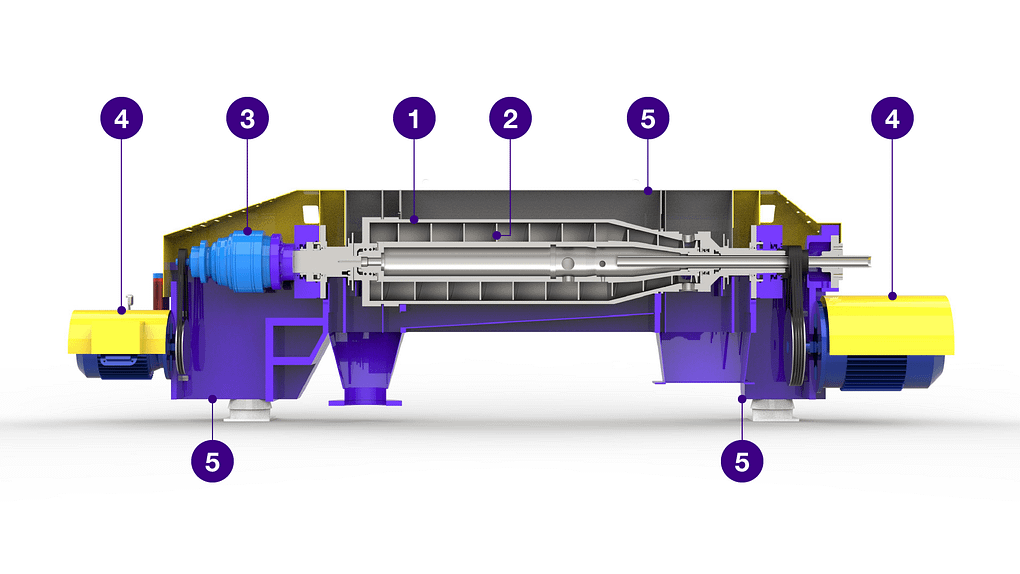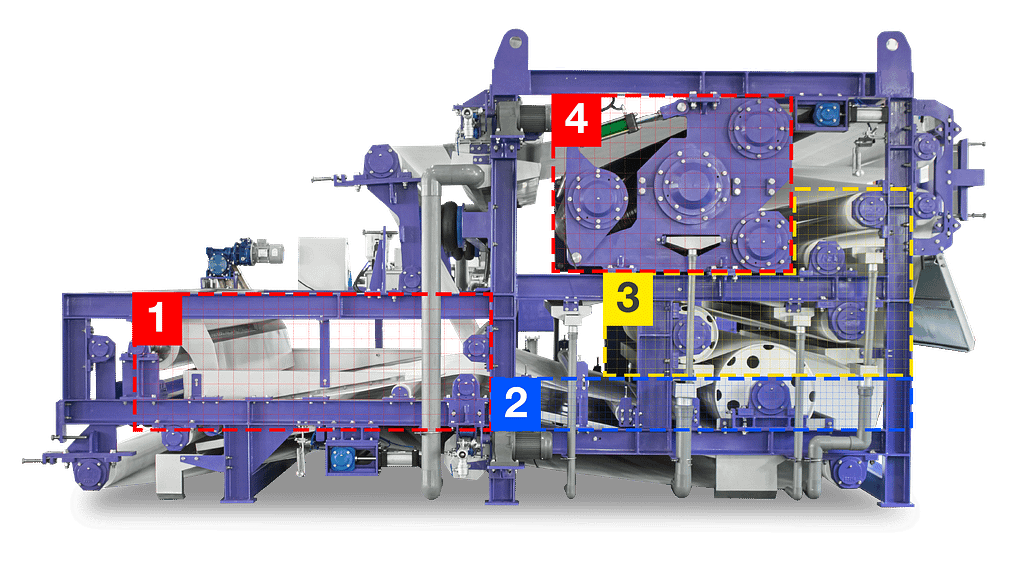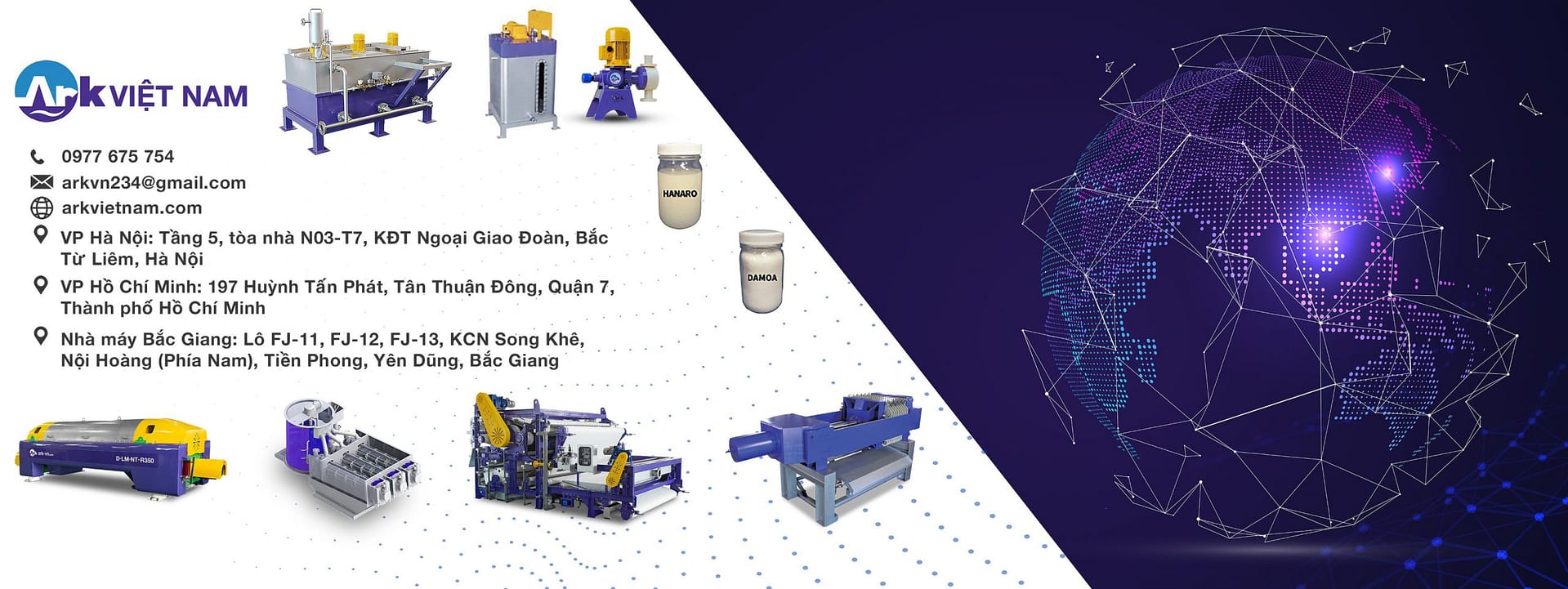
A dewatering machine is used to reduce the amount of moisture in the sludge generated in the sewage treatment plant. Among them, the most frequently adopted dehydrator is definitely a centrifugal dehydrator machine. The centrifugal dewatering machine is a method of separating sludge into solids and moisture using the centrifugal force.
1.1. Structure

Annotate:
- outer cylinder (Bowl);
- screw conveyor;
- gearbox;
- driving device;
- body.
 |
 |
 |
| outer cylinder (Bowl)-1 |
a screw conveyor-2 |
a gearbox-3 |
1.2. Specification
The capacity of the centrifugal dewatering machine is primarily proportional to the inner diameter of the outer cylinder, and most of the standards for each company include the inner diameter.
This is a specifications of a centrifugal dewatering machine, such as KOWATS-360D, KOWATS-420D for Company R; 300MTDI, 350MTDI for Company EWHA; DDE3532, DDE4042 for Company H. Or D-LM-NT-R350, and D-LM-NT-R400 for Company A.
Although the treatment capacity is shown according to this specification, each company has different experience values, and each country has different sewage/waste sludge properties, and there is a large difference in treatment capacity for various reasons such as reference sludge concentration and organic content. For this reason, it is difficult to write down the treatment capacity on a certain basis.
1.3. Reference capacity
If the concentration of sludge is 1%
- D300 of ARK Vietnam can treat 5 tons of sludge, maximum.
- D350 10 tons;
- D400 17.5 tons;
- D450 25 tons;
- D500 30 tons;
- D550 35 tons;
- D600 42 tons;
- D650 50 tons. Actual capacity is lower about 10-20%.
If the sludge concentration is 2%
- D300 can treat 3.5 tons of sludge, maximum;
- D350 5 tons;
- D400 9 tons;
- D450 20 tons;
- D500 25 tons;
- D550 30 tons;
- D600 35 tons;
- D650 42 tons. Actual capacity is lower about 10-20%.
If the sludge concentration is 3%
- D300 can treat 2 tons of sludge, maximum;
- D350 4 tons;
- D400 7.5 tons;
- D450 14 tons;
- D500 20 tons;
- D550 25 tons;
- D600 30 tons;
- D650 32 tons. Actual capacity is lower about 10-20%.
The excess sludge concentration of 4%
The excess sludge concentration of 4% or more is difficult to react by mixing polymer and sludge. However, raw sludge, mixed sludge (excess + raw sludge), and sludge with high inorganic content are estimated that it is possible to treat. But it is preferable to check the degree of reaction with polymer, before treatment.
1.4. Conclusion
There are various type of sludge depending on concentration, pH, fiber content, inorganic content, and other ionization degree, and has very different throughput and water content depending on these properties, and thus consultation with an expert is needed.
 |
 |
| RT Type |
ST Type |
The dehydrator multi-disk screw press was developed in Japan around 1990 and is popular in South Korea and China, and is gradually spreading to Europe, The dehydrator multi-disk screw can divide two types according to the driving method, but the basic principle is that the flow plate moves with respect to the fixing plate, the dewatering water is emitted through the gap
between the fixing plate-1 and the flow plate-2, and the sludge is compressed with a screw rotating inside the muti-disk cylinder.
2.1. Structure

Annotate:
- fixing plate;
- flow plate;
- muti-disk cylinder;
- screw conveyor;
- gear;
- power device.
The dehydrator capacity is primarily proportional to the screw diameter, and the specifications for each company is often indicated by diameter.

2.2. Specification
Most of the specifications do not match the screw diameter, it is necessary to check which part of the diameter the specification indicates. Included is the number of screws integrated in the machine. Example:
- The dehydrator Multi-disk type specifications are KS-ST202 for Korean company A;
- GS101, GS131, GS201, GS202, GS302 for Japanese company A, have 1 to 2 screws respectively with different shaft diameter;
- Chinese company K is marked as KTDL251, KTDL352, KTDL403 with 1, 2 and 3 screws.
Although the treatment capacity is shown according to the specifications, each company has different experience values, and each country has different sewage/waste sludge properties, and there is a large difference in treatment capacity for various reasons such as reference sludge concentration and organic content.
For this reason, it is difficult to write down the treatment capacity on a certain standard. The name of the model already shows its structural characteristics.
- Company A KS- 202 indicates that there are two 200 types of screws and China K Company KTDL352 indicates that there are two 350 types.
- South Korean company A's 100 type has a screw diameter of 102mm, 200 type 170mm, 400 type 310mm.
- Japanese and Chinese companies 100 type have a screw diameter of 100mm, 200 type 170mm, 300 type 236mm, 350 type 284mm.
2.3. Reference capacity
Generally, if the concentration is over 0.6%, the treatment capacity of the multi-disk dehydrator is affected by the sludge solid content rather than the treatment volume, and if the concentration is below 0.6%, the treatment volume is affected.
In the case of ARK Vietnam Co., Ltd:
- The 100 type treats 0.8 ton sludge at a concentration of 0.6%, 0.5ton at a concentration of 1%. 0.35 ton at a concentration of 2%.
- The 200 type treats 1.5 tons sludge at a concentration of 0.6%, 1 ton at a concentration of 1%. 0.8 ton at a concentration of 2%. 0.5 ton at a concentration of 3%.
- The 400 type, it is expected to be treated at a concentration of 0.6% is 3 tons sludge. At a concentration of 1% is 2 tons. At a concentration of 3% is 1.5 tons.
For other foreign manufacturers:
- The GS130, GS200 machines of Japan and China will be equivalent to KS100, and KS200 of ARK Vietnam.
- GS300, GS350, GS400 versions are not much different
However, when the screw diameter is 400 mm or more, the treatment of dehydration is not increased proportionally according to Screw diameter and the moisture content may be increased highly.
 |
 |
| Standard type |
High-pressure type |
The Belt press dehydrator is the earliest developed dehydrator and is the first model introduced in South Korean wastewater treatment plants, and has been the most popular in the past. However, when washing the belt, a large amount use of water and difficult to collect odors in a sealed structure, so it is significantly less used in South Korea than before.
3.1. Structure
The belt press dehydrator consisted of a pair of filter cloths and a plurality of roller systems. The belt press can be divided into four dehydration zones as below. The sludge introduced into the gravity dehydration unit is sequentially separated into filtrate and cake.

Annotate:
- gravity dehydration zone;
- roll pressing dehydration zone;
- low-pressure dehydration zone;
- high-pressure dehydration zone.
3.2. Specification
If the belt press dehydrator is largely classified, it can be classified into a general dehydrator with 6-8 stages of general rollers.
The high-pressure belt press that compresses at high pressure by inserting a separate driving device of the high pressure into the general dehydrator. In addition, belt presses such as paper wastewater can be classified into special belt presses designed to suit sludge with high use efficiency.
 |
 |
 |
 |
| Air-pressure support mechanism maintains the belt tensity |
Sensors detect the deviation of the belt |
Mechanism adjust the belt in case it deviates |
Hydraulic mechanism to increase the pressure on the belt |
Each type of ARK's belt press is divided according to the width of the filter cloth. With widely used versions such as:
- 0.5 m long conveyor belt;
- 1 m long conveyor belt;
- 1.5 m long conveyor belt;
- 2 m long conveyor belt;
- 2.5 m long conveyor belt;
- 3 m long conveyor belt, etc.
2.3. Reference capacity
- If the treated sludge moisture content is 78% or less, the active sludge and the wastewater sludge are calculated at 100-80 kg-DS/hr^1m.
- The moisture content of about 80% sludge is calculated at 80-70 kg-DS/hr^1m
- The sludge with a moisture content of 82% or more is desirably designed to 70-50 kg-DS/hr^1m.
The initial sludge with low sludge concentration needs to be concentrated by 2-3% or more, to work efficiently.
























